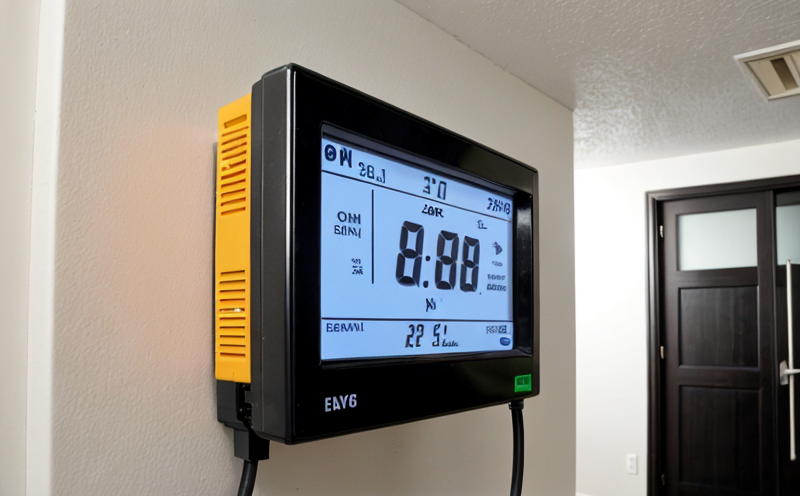ASTM E779 Air Leakage Testing for Building Efficiency
The ASTM E779 standard provides a method to determine air leakage rates through building assemblies. This is critical in ensuring buildings are energy-efficient, as excessive air leakage can lead to increased heating and cooling costs, poor indoor air quality, and potential structural damage over time.
ASTM E779 is widely recognized for its detailed procedures that help identify the amount of uncontrolled air flow through a building envelope. This test is particularly important in sectors like residential construction, commercial buildings, and industrial facilities where maintaining optimal environmental conditions is crucial. The test measures the infiltration or exfiltration of air through gaps and cracks, which can significantly impact energy consumption.
The methodology involves creating a controlled environment around the specimen by applying a pressure differential between two areas: inside and outside the building. This differential pressure simulates real-world conditions that might cause air leakage. The test apparatus typically includes fans to generate this pressure difference and sensors to measure airflow rates accurately. Specimens tested can range from small components like windows or doors to entire buildings.
The acceptance criteria for ASTM E779 are based on the allowable air infiltration rate, which varies depending on the type of building assembly being tested (e.g., walls, roofs, floors). Compliance with these standards ensures that structures meet specified energy efficiency levels set by local codes and regulations. By adhering to ASTM E779 guidelines, stakeholders can verify that their projects comply with industry best practices and contribute positively towards sustainability goals.
Understanding the importance of air leakage testing is essential for quality managers looking to ensure high standards across all aspects of construction. Compliance officers will find value in this test as it helps maintain regulatory adherence by providing reliable data on energy efficiency performance. R&D engineers benefit from accurate measurements during product development cycles, while procurement professionals can use these results when selecting suppliers and materials.
Given the growing emphasis on sustainable architecture and green building practices, ASTM E779 plays an indispensable role in promoting efficient design and construction practices that reduce environmental impact without compromising functionality or aesthetics. Proper implementation of this standard contributes significantly to achieving long-term savings through reduced energy costs while enhancing occupant comfort and health.
For those involved in the planning stages of new projects, understanding how ASTM E779 applies directly influences decisions regarding building envelope design choices. It also impacts material selection processes where durability meets insulation requirements effectively. In existing buildings undergoing renovation or retrofitting efforts aimed at improving energy efficiency, this test offers valuable insights into current performance levels and potential improvements possible.
By leveraging the expertise provided by ASTM E779 air leakage testing services offered here, organizations can confidently address challenges related to building envelope integrity while contributing positively toward sustainability objectives. Our team of experienced professionals ensures accurate interpretation and application of these standards ensuring compliance with relevant codes and regulations.
Scope and Methodology
The scope of ASTM E779 covers the determination of air leakage rates through building assemblies using standardized procedures. This includes both new constructions as well as existing buildings undergoing energy efficiency upgrades or assessments. The primary objective is to quantify the amount of uncontrolled airflow passing through gaps, cracks, and other openings in the building envelope.
The methodology begins with setting up the test environment by sealing off all exterior walls except for a designated area where measurements will be taken. A calibrated fan is then installed to apply a controlled pressure differential across this opening. The rate of air flow outwards or inwards due to this difference can be measured accurately using anemometers and other sensing devices.
- Industry Applications: Residential, commercial, industrial buildings; retrofitting projects
- International Acceptance and Recognition: Widely adopted globally for compliance purposes
The test results are typically reported in cubic feet per minute (CFM) or equivalent units. These figures serve as a baseline against which future improvements can be measured, helping to track progress towards achieving desired energy efficiency goals.
Industry Applications
- Residential Construction: Ensures homes are well-insulated and comfortable year-round. Reduces heating and cooling costs significantly by minimizing unnecessary heat loss or gain.
- Commercial Buildings: Enhances operational efficiency for office spaces, retail outlets, hospitality establishments, etc., resulting in lower utility bills and improved occupant satisfaction.
- Industrial Facilities: Critical for maintaining consistent production temperatures regardless of external weather conditions. Helps prevent contamination issues common in clean rooms or manufacturing environments sensitive to air quality changes.
- Retrofitting Projects: Allows existing structures to meet updated building codes and standards, thereby extending their lifecycle while enhancing overall performance.
The data obtained from ASTM E779 testing can inform design decisions during initial stages of project planning. It also guides material selection processes ensuring durability alongside thermal insulation properties. Furthermore, it supports continuous improvement initiatives aimed at optimizing energy usage over time.
International Acceptance and Recognition
Air leakage testing is a global concern due to its significant impact on energy efficiency across various sectors. ASTM E779 has gained widespread acceptance worldwide as an authoritative reference for determining air infiltration/exfiltration rates through building envelopes.
- United States: ASTM E779 is recognized by numerous state and federal agencies including the Department of Energy (DOE) and the Environmental Protection Agency (EPA).
- European Union: Many countries within the EU have adopted similar standards based on EN 13829, which aligns closely with ASTM E779.
- Canada: The National Energy Code for Buildings (NECB) references ASTM E779 when specifying requirements related to building envelopes and air tightness.
The international recognition of ASTM E779 underscores its importance in promoting best practices globally. By adhering to these standards, stakeholders ensure compliance with local regulations while contributing positively toward broader sustainability goals.





